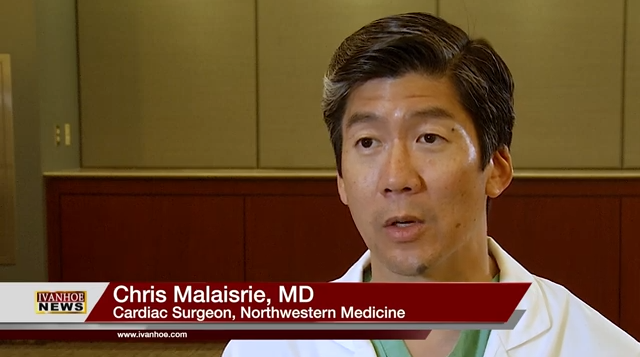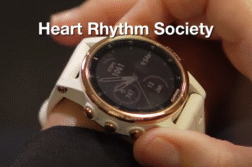Northwestern Medicine cardiac surgeon, Chris Malaisrie, MD, talks about treating CTEPH.
Interview conducted by Ivanhoe Broadcast News in 2023.
What is CTEPH?
Malaisrie: Yeah. So Chronic Thromboembolic Pulmonary Hypertension, or CTEPH for short, which is the acronym, is a rare condition that patients get after an acute clot. So most patients who survive an acute pulmonary embolism will go on to later dissolve that embolism. However, in a small subset of patients, those clots become chronic, meaning that they won’t go away. They scar into the walls of the pulmonary artery, and they start obstructing blood flow to the heart. And they cause a condition called pulmonary hypertension, which is elevated blood pressures in the lung circuit.
Tell me a little bit about the main symptoms.
Malaisrie: Yeah. The main symptoms of CTEPH are shortness of breath and exercise intolerance. So mostly, most of the time, young patients will complain of the fact that they just don’t have the same stamina that they had in the past. They’re unable to do exercises they were once able to do in a full capacity.
Is this is something that sometimes goes undiagnosed and untreated and people just live with it?
Malaisrie: It doesn’t go undiagnosed, but it does go misdiagnosed. So a lot of patients get diagnosed with a more common condition such as asthma or COPD. They’re given treatments that really don’t benefit them because it’s not treating their disease. With CTEPH it is an obstruction in the circuit, in the lungs itself. So blood’s not getting through the lungs to get oxygenated and back to the heart, into the rest of the body.
What do people mistake it for? What is it similar to that it gets misdiagnosed?
Malaisrie: Yeah. Their main symptom is what we call shortness of breath, or breathlessness. Medical professionals call a dyspnea. So patients are short of breath. So there’s a whole list of diseases that could cause shortness of breath, asthma and COPD are at the top of the list. And a lot of patients with CTEPH are misdiagnosed with that.
What are the risks with the misdiagnosis?
Malaisrie: Right. Untreated CTEPH can be a bad problem, because it could lead to pulmonary hypertension, which is elevated blood pressure in the lung circulation. With high blood pressure in the lung circulation, it causes the heart to fail. Because the heart has to work really hard to push blood past the lungs. So if you leave it alone for a long time, patients will eventually get heart failure.
What causes this?
Malaisrie: CTEPH is caused by acute pulmonary embolism. So patients who have an acute pulmonary embolism, I think most of us recognize that as an emergency patients come in with very symptomatic shortness of breath. Sometimes shock low blood pressure, and we have to do some immediate treatment such as blood thinners. Sometimes we have to go in and get the clots out. Most of those patients are able to dissolve that clot over time. CTEPH happens because the patient is unable to dissolve blood clots that collected in the lungs.
I know you said that it is sometimes misdiagnosed, but what is it, how is it diagnosed successfully?
Malaisrie: Yeah. The first way these things are picked up is with echocardiography. So echocardiography is an ultrasound of the heart, and with that we can see that the heart is struggling to push blood through. We can actually measure and get an estimate of the blood pressures in the lungs, and they can make a preliminary diagnosis of pulmonary hypertension. It’s this suspicion that leads us to further testing.
How is the treatment?
Malaisrie: Treatment for CTEPH includes three things. One is medical therapy, there’s one approved pill for that. Another is surgery, that’s the definitive diagnosis surgery, meaning open heart surgery. We go in and remove the clots from the inside of the lung. And the last treatment is balloon pulmonary angioplasty. That’s an interventional procedure where we go in through the blood vessels in the leg, and we can balloon blood vessels in the lungs to open up blood flow.
What’s involved with the surgery?
Malaisrie: Yeah. Surgery for CTEPH is open heart surgery. So the incision is an up and down incision in the front. We use the heart lung machines. The heart lung machine takes blood from the patient, gives it blood pressure, takes away CO2 gives it oxygen, we return it to the body. We need to do cardiopulmonary bypass for the heart-lung machine in order to remove these clots, because what we have to do is cool the body temperature down. We are able to take a look inside the pulmonary artery, turn the circulation off, so there’s no blood flooding in the field. And then in meticulous fashion, slowly peel that clot away from the pulmonary artery.
After the surgery, are they cured?
Malaisrie: Yeah. About half the patients we consider cured, meaning that the pulmonary hypertension is completely resolved. But almost all the patients have a dramatic symptomatic improvement. So patients know sometimes immediately, that the breathing is better. And we can measure the blood pressure inside the lungs, the pulmonary hypertension, and we’d find that the pulmonary hypertension goes away to about half the patients. We expect those blood pressures to be reduced by 50%.
Is there any risk of re-occurrence?
Malaisrie: The risk of re-occurrence is very low, provided the patient remains on the blood thinners, the patient has committed to blood thinners for the rest of their life. And there’s a whole list of blood thinners that are available right now. So a patient remains on the blood thinners, there’s a very low chance that the CTEPH can recur.
We’re interviewing Jessica Lopez. She’s near our location down in Florida, lucky enough. From what I understand, she was up here on vacation. Tell us about Jessica.
Malaisrie: And that was a very special case. She was on a road trip with her friend and she’s making a visit through Chicago. She wasn’t feeling good, she ended up on the emergency room. She’s never had the diagnosis before, but I think she did have a remote history of an acute clot, so an acute pulmonary embolism. That was the first tip off that something was wrong. So with advanced imaging including echocardiography, CT scan, angiography, we’re able to make a diagnosis that one side of her, one lung on the right side was completely filled with clot. No blood flow was going through one side. And that led us to the diagnosis of CTEPH.
That sounds, obviously, pretty serious. Is she an average case or is she a rare case?
Malaisrie: This is a pretty typical case for CTEPH. Sometimes the clots can be very central, so there are large clots and no blood is going through. Sometimes the clots can be very distal, meaning in the branches of the pulmonary artery. And that has some ramifications on how difficult the operation was, for her she was fairly straightforward operation in order to remove those blood clots from both sides.
I’m going to say she had the PTE successful, right?
Malaisrie: Yeah. It was really successful. And I think we provided the newspaper with pictures of the clot. I think she’s more than happy to show you pictures of the clot they were able to remove from her.
As you know she was into Roller Derby. Is she’s safe to go into Roller Derby again?
Malaisrie: Well, I think she can. She noticed an almost immediate benefit in her breathing after the surgery. And from what I hear, she is back to normal activities. It would not surprise me at all if she went back to do Roller Derby.
What do you want people to know about CTEPH?
Malaisrie: Yeah. Someone with shortness of breath. Consider CTEPH as a potential reason for shortness of breath. Some clues that the patient will have is, they had an acute clot sometime in the past. Because sometimes those acute clots don’t go away entirely, and they can scar into the lungs, turn into a chronic clot, because we’ve got great therapies for it. Open heart surgery, the pulmonary thromboendartectomy surgery, we consider to be curative in a lot of patients. So there’s an opportunity for treatment that is safe and effective.
Jessica just happened to be in town at the right place at the right time for this occurrence, right?
Malaisrie: Yeah. Well. If Jessica was really lucky to wander into our emergency room at Northwestern Memorial Hospital because we do have an expertise in clots of the lungs. And for us, chronic clots in the lungs is a specialty of ours, because we have virtually all the treatments available, including medical therapy pills to help prevent it, and possibly treat it. Open heart surgery, which we consider curative, and balloon pulmonary angioplasty for cases that aren’t candidates for surgery.
Does she have to come back here for follow ups, or is she able to do follow up elsewhere?
Malaisrie: No. She doesn’t have to come here for followup. There’s excellent medical doctors around in Orlando. We’re here if she needs any more work in terms of balloon pulmonary angioplasty. But I think if her symptoms are resolved, the post-op imaging looks like we did a really great job for her. I don’t expect her to have to come back for any more treatment.
END OF INTERVIEW
This information is intended for additional research purposes only. It is not to be used as a prescription or advice from Ivanhoe Broadcast News, Inc. or any medical professional interviewed. Ivanhoe Broadcast News, Inc. assumes no responsibility for the depth or accuracy of physician statements. Procedures or medicines apply to different people and medical factors; always consult your physician on medical matters.
If you would like more information, please contact:
Megan McCann
Sign up for a free weekly e-mail on Medical Breakthroughs called First to Know by clicking here




